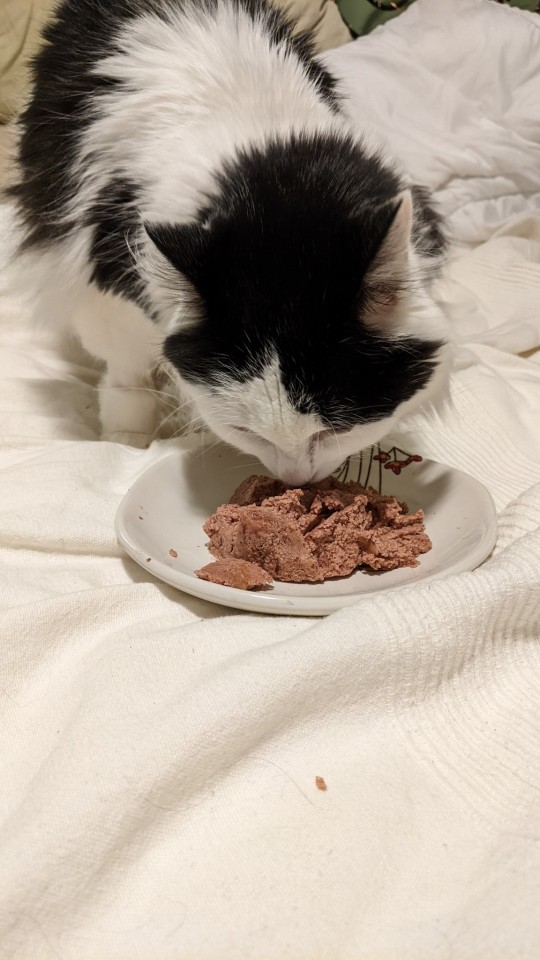#source: re-ment
Photo






星のカービィ「Swing Kirby in Dream Land」
#kirby#waddle dee#hoshi no kirby#figure#nintendo#re-ment#official product#from official product photo#transparent#my edit#do not repost#source: re-ment#release: 8/14/2023#cute#png#want waddle dee and round
2K notes
·
View notes
Text








Cinnamoroll re-ment
#sanrio#sanrio aesthetic#sanriocore#hello kitty aesthetic#cute pngs#hello kitty#sanrio png#transparent#hello kitty png#sanrio core#Cinnamoroll#source link#re ment#cafe#miniature#mini#cafe set#toy set#blind boxes#toy sets#toys#drink#food#milk cinnamoroll
258 notes
·
View notes
Text
Someone the other day asked for our bubble tea "vegan option" and I was just like "? ...it's made with a soy-based creamer by default?" But he was like "No, the honey. I don't want honey." And I was just like. "......Ok."
Dude came in again today and he stank soooooo bad I literally nearly gagged. Bro apparently runs like a mile or some shit to get bubble tea as part of his exercise routine. & it's just like. OK Bro
#speculation nation#the honey thing threw me off bc im so divorced from anything vegan that i just did Not register it#like bro just say you dont want honey 😭 it's not that hard 😭#dont gotta push ur damn vegan thoughts on me. im gonna slurp that honey as much as i fuckin want#and while im at it eat many eggs and drink cows milk and eat cheese and MEAT oh god forbid#i mean like vegetarian i think is more reasonable bc by an empathy standpoint it can fuck with ppl to eat meat#and also for religious purposes and such. & dietary restrictions for dairy and whatever is perfectly understandable#but if ur refraining from all animal products bc of like. Morality re: animal cruelty like. bro. Bro.#unless you grow all your food yourself much of your 'vegan' options are much more awful with how theyre sourced#except cruelty to humans doesnt matter as much as cruelty to animals to you. like. Ok bro.#sure whatever save the bees. quick question what do you do if there are gnats in your house?#do you gently usher them away? pick them up with a cute little paper towel to get them out? it doesnt work like that.#even if honey industry killed bees (which it doesnt) do you still think that's more important than preventing child labor?#i agree we shouldnt kill bugs willy-nilly but Man. sometimes you just gotta kill some bugs. the fuck?#bugs ment/
1 note
·
View note
Text






Source: Re-Ment Sanrio Terrarium
219 notes
·
View notes
Text
There is something so, so wrong about the fact that Shadow's vet bill today was $85, but the Uber to and from was $65. However, Dr Margaret (whom I love deeply and with all my heart and nerd love) gave Shadow a thorough once-over and apart from a slightly elevated temperature, and needing to put on some of her lost weight (albeit some of the weight recorded at MedVet likely included the gigantic BEZOAR they removed from her GI tract) pronounced her in excellent condition and very nicely healed up from her surgery. She also decreed Shadow no longer has to wear the banana pants onesie and can resume her carefree life of public nudity!



Whether it was freedom from wearing clothes, or just excited to be home from the vet, she then demolished about a third of a 3 oz can of wet food which brought me stupid amounts of joy because I have been fretting and tying myself in knots over how much she hasn't been eating and drinking even though she has been eating and drinking. I am a fan of please drink more water. All the water. Candice even got her milk that is especially for cats! And she has been eating the milk-flavoured Temptations cat treats. Which, while they should not be her sole source of sustenance, are still calories and still count as far as I'm concerned.
In order to avoid having to pay interest on the $8000 deposit, it's very important that we raise the remaining $5,000 before April 1st. I am further culling my 1:6 scale collection of dolls, miniatures, and diorama furniture which are sold on consignment by the wonderful Pamela at TinyFrockShop.com. So if you are also a 1:6 action figure or doll nerd, there will be great deals to be had on some Holy Grails like Vitra Design Museum replicas, rare convention Poppy Parker dolls, and lots and lots of Re-Ment.
Please help signal boost by reblogging this post, sharing the link to our GFM, and please donate if you can! Every little bit helps, and we appreciate all of you so incredibly much.
13 notes
·
View notes
Note
Ciao! Volevo chiederti se avessi dei consigli per libri su Friederich in italiano (o in inglese) & dove comprarli. Io sono riuscitx a trovare solo quello di Alessandro Barbero. Adoro i tuoi disegni e il tuo blog! (trovo molto ironico il fatto che io abbia dovuto riscrivere questo messaggio perché Fritz (il mio gatto) si è fatto una camminata sulla tastiera)
la gioia di scrivere i post in italiano finalmente 🧎🏻♂️ CIAO
allora, anzitutto grazie dei complimenti,, 😭 ho dei libri in italiano (e inglese), però ti devo avvertire che sono molto pochi e non si trovano tanti romanzi, la maggior parte sono (tristemente ma comprensibilmente) in tedesco, ma ti faccio comunque una lista partendo da quelli c:
re in prussia di rafael sabatini – conta che non lo trovi in libreria, devi comprarlo usato oppure affidarti a questo link se riesci a leggere le cose online senza problemi (io non riesco e l'ho trovato usato), è sia in italiano che in inglese, ma è pure del '44 (o '47? non ricordo) quindi il linguaggio è quello che è... in italiano è un po' tedioso, fritz è un queer disney villain e il protagonista è un oc di sabatini antipatico come pochi, però... if you squint hard enough...
federico il grande di william f. reddaway, è una biografia, io ho letto solo i pezzi che mi interessano per il progetto e ti posso dire tranquillamente che ci sono delle imprecisioni storiche perché è un libro del suo tempo... ma ci sono le figure!! e ha una copertina figa. pure questo lo trovi usato, sia in italiano che in inglese
stesso titolo, ma di nancy mitford – biografia, la trovi usata, sia italiano che inglese, è divertente da leggere ma non ci sono le fonti </3 quindi è un po' tutto un "source: trust me bro". sempre suoi, "voltaire innamorato" e "madame du pompadour", il primo in italiano, il secondo in inglese, sempre usati
the sorrows of frederick di romulus linney – è un copione di uno spettacolo, PIENO di imprecisioni storiche, solo in inglese (e usato, che te lo dico a fare) keith non esiste, katte è solo "hans katte" e appare per tipo 2 scene per poi morire tragicamente, però è divertente da leggere e se avessi un euro per ogni volta che le emorroidi vengono menzionate in questo libro avrei due euro, che non è molto, ma è strano che sia successo due volte
bad gays di huw lemmey e ben miller ha un capitolo che lo riguarda, esiste in italiano (non usato!!) e ci sono delle illustrazioni bellissime, ma ti dirò... a una certa mi ha sorpreso con un f slur e ho detto "HUH??" e ci sono delle parti che mi hanno un po' confuso storicamente parlando, però carino... pure se inizia con un pezzo di "la jouissance"... bleurgh
la musica del re di gabriele formenti, te lo metto solo per correttezza perché è nella mia libreria ma me ne vergogno. è orrendo. terrificante. mi ha distrutto psicologicamente così tanto che mi sono fermatx a pagina 42 e ho detto BASTA non ne posso più man che cos'è questa merda... a un certo punto ti colpisce con un "[inserire nome di un personaggio femminile] si adattava benissimo alla corte di potsdam" girl who tf 😭 no she didn't 😭
e basta, finché ricordo questi sono quelli che ho a parte quello di barbero! abbi pazienza ma ti sto rispondendo mentre sto in stazione quindi non li ho tutti sottomano per controllare </3 ce ne sono altri in tedesco che sono belle letture, se mi viene in mente qualcos'altro ti faccio un fischio!
#answers#sono talmente disabituatx a rispondere in italiano qui che scrivere questo post è stata un'impresa#ma mi ha fatto piacerissimo 😭
19 notes
·
View notes
Text
I can't reblog it for some reason, but regarding a thread about how awful Mao is and how his policies killed a hundred billion people, I think this is significant.
---
DETROIT — Another country that once had an addiction problem—one that lasted for almost 200 years and involved an incredible 25 per cent of its population—is China.
Today China is virtually drug‐free— and the methods the Chinese used to eradicate their addiction problem might well offer methods we could use to achieve the same results.
China was forced into addiction by the Opium Wars. Contrary to popular belief, these wars—from 1839 to 1842 —did not originate because China wanted to export opium. They began when China resisted England's demand to import opium in exchange for Chi nese products—mostly tea, silk, and porcelain. China lost these wars, and among other indignities was forced to exchange its goods for opium. As a result it became a highly narcoticized country, a victim of ruthless Western economic and political policy. By 1850 an entire fifth of the revenue of the British Government of India — the source of opium — came from Chinese consumption of this drug.
Obviously to enlarge the market for opium, China was forced to create a huge number of addicts. And it did.
In October of 1949 the People's Re public of China was proclaimed. With in a year the Communist Government instituted a comprehensive program designed to eliminate this threat to the nation. All evidence indicates that by 1953 the problem of narcotic drug abuse was practically eliminated.
One important factor was the changed ideology of the young people —no new supply of addicts was forth coming. The changes in outlook in cluded a redefinition of the nation and its youth, of their worth and role. In rural areas this new definition was based on land distribution; collective farming; new educational, social, and vocational opportunities; and the elec tion of local councils. In the cities it took the form of nationalization of commerce and industry, full employ ment, worker control, and the end of foreign domination.
This total ideological transformation of the younger generation was accom panied by the reintegration of Chinese society through small street commit tees that offered cultural leadership.
Equally significant in the Chinese drive to eliminate narcotic addiction were its methods of plugging the source, China is 80 per cent rural, and an unknown but significant part of the land had been turned into poppy cul tivation. The first major economic and political mass campaign of the Gov ernment was land reform, and this aim was coordinated with elimination of poppy growth. Distribution of land from large landholders to landless peasants was accompanied by the need to convert the opium cash crops to badly needed food crops. Today China produces enough opium to meet its medical needs, but no more.
Smuggled opium was still a source of the drug, and China acted to stop this supply with a policy of “carrot and stick.” Leniency was recom mended for employes and workers of opium traffickers; but heavy penalties existed for those controlling the traf fic, manufacture, or growth of opium.
China's attitude toward the individ ual reformed addict was one of good willed congratulations, and represents another important reason why the nar cotic problem was overcome. The re habilitation of opium addicts began with their registration. Arrangements by city‐wide antiopium committees for addict rehabilitation included treat ment to break the habit at home, in clinics and in hospitals.
At every stage of personal rehabili tation the ideological motivation was stressed. Given China's attitudes, this ideology was strong on political, so cial, and economic information. But the important thing is that the anti drug campaign recognized that the de sire and will of the addict is ultimately the controlling factor of addiction. China's policy was not simply to de prive a person of drugs, but to replace the need for narcotics with a forceful, national commitment. Equally signifi cant, the former addict was fully ac cepted back into Chinese life without official stigma or prejudice.
Naturally, many questions have to be answered about the total success of the Chinese experience. Is there an addict population living in labor camps or prisons because of failure to re habilitate? Do the rehabilitated addicts all function as useful members of Chi nese society? To what extent would addiction be a problem in China if its internal and border controls were less stringent? Does traditional Chinese medicine offer useful ideas about ad diction treatment?
---
Wikipedia puts the census count in 1950 at 546,815,000, and a quarter of that is 136,703,750. So about that many people saved from opium addiction by the Communists.
I wonder if that's the reason the West wants to focus so much on the famine.
13 notes
·
View notes
Text
i realize that monster culture (seven theses) by jeffrey cohen is meant to extend to fictional monsters specifically but i've decided it is a biblical text in my dramaturgical process specifically as it pertains to opera. in fact i think it is a better treatment of what opera fundamentally is than some other opera dramaturgy processes, even though those are specifically designed for opera and monster culture certainly isn't, and it applies both to an understanding of how operas should be reinterpreted and how they should be written in my opinion.
here's my thinking.
the monster's body is a cultural body- The monster is born only at this metaphoric crossroads, as an embodi- ment of a certain cultural moment—of a time, a feeling, and a place. The monster's body quite literally incorporates fear, desire, anxiety, and fantasy (ataractic or incendiary), giving them life and an uncanny in- dependence. The monstrous body is pure culture.
Opera is a reflection of culture. Every opera reflects three things: the time period and situation of the source material, time period and situation of the composer and librettist, and the time period and situation of the time in which it is staged. For example, Mozart's Don Giovanni contains this triptych of culture situations pretty obviously: The source material, the Don Juan plays starting with Tirso de Molina, are a satire of Spanish power and libertinism. The composer was dealing with the death of his father, a loss that comes through in the sense of grief around the piece and its central character theme. And finally, in the modern day patriarchal structures have increasingly come under scrutiny, which affects how the scenes between Don Giovanni and the various women are performed. Opera operates both outside of time and very strictly within it, which is at once paradoxical, problematic (in terms of figuring out how to produce it), and miraculous.
2. the monster always escapes- No monster tastes of death but once. The anxiety that condenses like green vapor into the form of the vampire can be dispersed temporarily, but the revenant by definition returns. And so the monster's body is both corporal and in- corporeal; its threat is its propensity to shift.
An opera has to be designed in such a way that it can be performed over and over. It has to strike a perfect balance between the cultures mentioned in Thesis 1. An opera has to leave some things unfinished and ask questions no one staging can truly answer. The problem with a lot of operas that fall to the wayside immediately is that they are built for a specific moment, which may serve them for that moment but certainly does not declare longevity. An opera must leave some things unsolved to perpetuate itself- it must perfectly resonate with its cultures, but it must also be so imperfect as to allow for future productions and re-interpretation.
3. the monster is the harbinger of category crisis- Because of its ontological liminality, the monster notoriously appears at times of crisis as a kind of third term that problematizes the clash of extremes—as "that which questions binary thinking and introduces a crisis." This power to evade and to undermine has coursed through the monster's blood from classical times, when despite all the attempts of Aristotle (and later Pliny, Augustine, and Isidore) to incorporate the monstrous races into a coherent epistemological system, the monster always escaped to return to its habitations at the margins of the world (a purely conceptual locus rather than a geographic one).
There is no hard difference between what constitutes an opera and what constitutes anything else. The differences are purely in technique and culture. An opera should not only be allowed but encouraged to entangle with other genres of music and art. It has always drawn upon other art, and has always been a sort of half-creature between different genres and cultures. Attempts to discredit an opera because of its genre alone- ie the recent inflammatory attempts to discredit Terence Blanchard's operatic work on the foundation that it roots much of its style in Black American jazz and not "traditional European orchestra" (in and of itself an extremely shaky non-category)- are entirely unfounded and created out of false (and often supremacist) ideas of opera as a cohesive genre. Sondheim thought of his works as musicals on Broadway and operas in the opera house, which is the best way to summarize this thesis.
4. the monster dwells at the gates of difference- The monster is difference made flesh, come to dwell among us. In its function as dialectical Other or third-term supplement, the monster is an incorporation of the Outside, the Beyond—of all those loci that are rhetorically placed as distant and distinct but originate Within. Any kind of alterity can be inscribed across (constructed through) the monstrous body, but for the most part monstrous difference tends to be cultural, political, racial, economic, sexual.
While an opera must be relatable to its audience in some capacity to be staged (see Thesis 1), an opera also has to be different enough that its resemblance to modernity lies more in an inherent truth than in deliberate resemblance. Operas often focus on characters who present as a distinct other, from the obvious examples like the physically disabled societal outcast of Rigoletto- to the otherworldly, like the troubles of Wotan and Brunhilde- to the subtle, like Figaro, cast into the streets before he ever knew who his parents were. An opera has to feel as though it is something else; an opera does not memorialize the ordinary. The more different an opera is, the more uncanny its resemblance to our modern world it becomes, and it becomes riper and riper with the possibility of revisitation.
5. the monster borders the policies of the possible- From its position at the limits of knowing, the monster stands as a warning against exploration of its uncertain demesnes. The giants of Patagonia, the dragons of the Orient, and the dinosaurs of Jurassic Park together declare that curiosity is more often punished than rewarded, that one is better off safely contained within one's own domestic sphere than abroad, away from the watchful eyes of the state... Lycaon, the first werewolf in Western literature, undergoes his lupine metamorphosis as the culmination of a fable of hospitality.
An opera is often a warning and an exploration of boundary. Many characters in opera are punished because of violating some taboo or another; (whether or not the narrative wants you to side with this punishment is up to both the work and its production). It is Nick Shadow's assurance that the narrative of the opera is on his side that keeps him from his victory. It is Baron Scarpia's defiance of morality that does him in when Tosca stabs him in the chest. Orpheus fails in his quest to bring back Eurydice because of the impenetrable boundary between the living and the dead. An opera clearly sets up its boundaries between its characters, and then revels in the consequences- for better or worse- when those boundaries are broken, be they class or gender, race or religion. The opera itself does not adhere to boundaries- see thesis 3- but it loves to depict them.
6. fear of the monster is really a kind of desire- Through the body of the monster fantasies of aggression, domination, and inversion are allowed safe expression in a clearly delimited and permanently liminal space... the monster can function as an alter ego, as an alluring projection of (an Other) self. The monster awakens one to the pleasures of the body, to the simple and fleeting joys of being frightened, or frightening—to the experience of mortality and corporality.
As much as opera is seen as an intimidating, ridiculous monster and something that "makes no sense", it is also deeply envied. No other art form captures such exaggerated emotion in the way opera does. It allows for projection and understanding of the self, and it allows for make-believe in a way that fulfills the great desires stunted by everyday life. Opera is envied as much as it is disliked, and the further one protests it, the more it appears as though opera just might appeal to them. As much as the violence, affairs, murder, and mayhem that dapple the operatic stage repulse the audience, they are also equally delighted by it. It is no wonder then that much of the most popular snippets of opera- La Donna E Mobile, Der Holle Rache- come from the darkest desires of its characters. Opera is big, loud, and unafraid of itself in such a way that both stupefies and entrances its audience. An opera cannot be anything but ridiculous in some way if it wants to exude power and desire.
7. the monster stands at the threshold... of becoming- Monsters are our children. They can be pushed to the farthest margins of geography and discourse, hidden away at the edges of the world and in the forbidden recesses of our mind, but they always return. And when they come back, they bring not just a fuller knowledge of our place in history and the history of knowing our place, but they bear self- knowledge, human knowledge—and a discourse all the more sacred as it arises from the Outside. These monsters ask us how we perceive the world, and how we have misrepresented what we have attempted to place. They ask us to reevaluate our cultural assumptions about race, gender, sexuality, our perception of difference, our tolerance toward its expression. They ask us why we have created them.
Opera is our strange collective stillborn; that which is dead and walks as though it is not. It was born out of a desire to revive the Greek theatre, even though we did not have the full understanding of what Greek Theatre truly was. We created it to raise the dead, and we kept it in the theatres because of its ability to resonate with us still despite long being outdated. Many operas do not truly die- they are banned from the stage, or fall out of favor, only to make their grand return in another century. They present portraits of people who are not quite ourselves but bear an uncanny resemblance, and then they ask us why we see ourselves in them. We created the constellations because we wanted to look into the sky and be met back with the faces of what we know, a perennial reassurance. And so it was we created opera because we wanted to look at artistic history and be met back with the faces of what we know, too. It is our own perception of the past and our fears of the present, come to find us. And what we do with it is truly up to us.
"It is true, we shall be monsters, cut off from all the world; but on that account we shall be more attached to one another." -Mary Shelley
26 notes
·
View notes
Text
hello there!!
i am just a person on the internet who finds re-ment’s figures absolutely charming, and figured setting up a blog dedicated to sharing them wouldn’t be such a bad idea. i use myfigurecollection.net and re-ment’s official site to source the photos.
7 notes
·
View notes
Text

That Midnight, When Nothingness Seeps from the Cracks
And finally, we can identify the most profound – ontological! – foundation for the Fourth Political Theory. Here, we should pay attention not only to theologies and mythologies, but also to the re- flective philosophical experience of one particular thinker who had made a unique attempt of constructing a fundamental ontology – the most summarizing, paradoxical, profound, and penetrating study of Being. I am talking about Martin Heidegger.
A brief description of Heidegger’s concept is as follows. At the dawn of philosophical thought, people (more specifically, Europeans, even more specifically, the Greeks), raised the question of Being as the focal point of their thinking. But, by thematizing it, they risked getting confused by the nuances of the complicated relationship between Being and thought, between pure Being (Seyn) and its expression in existence – a being (Seiende), between human Being in the world (Dasein – being-there) and Being-in-itself (Sein).
This failure already occurred in the teaching of Heraclitus about the phusis and the logos. Next, it is obvious in Parmenides’ work, and, finally, in Plato, who placed ideas between man and existence and who defined truth as the correspondence thereof, the referential theory of knowledge, this failure reached its culmination. This gave birth to alienation that eventually led to ‘calculating thinking’ (das rechnende Denken) and then to the development of technology. Little by little, man lost sight of pure Being and pursued the path of nihilism. The essence of technology (based on the technical relationship with the world) expresses this continually accumulating nihilism. In the New Era, this tendency reaches its pinnacle – technical development (Gestell) ultimately displaces Being and crowns ‘Nothingness’. Heidegger bitterly hated liberalism, considering it an expression of ‘the calculation source’ which lies at the heart of "Western nihilism."
Postmodernity, which Heidegger did not live to see, is, in every sense, the ultimate oblivion of Being, it is that “midnight”, when Nothingness (nihilism) begins to seep from all the cracks. Yet his philosophy was not hopelessly pessimistic. He believed that Noth- ingness itself is the flip side of pure Being, which – in such a para- doxical way! – reminds mankind of its existence. If we correctly decipher the logic behind the unfurling of Being, then thinking man- kind can save itself with lightning speed at the very moment of the greatest risk. “Where danger lies, there too grows the chance for salvation," Heidegger says, quoting Friedrich Hölderlin’s poetry.
Heidegger used a special term, “Ereignis” – the ‘Event’, to describe this sudden return of Being. It takes place exactly at midnight of the world’s night – at the darkest moment in history. Heidegger himself constantly vacillated as to whether this point had been reached or – ‘not quite yet’. The eternal ‘not yet’...
Heidegger’s philosophy may prove to be that central axis threading everything around it – ranging from the reconceived second and third political theories to the return of theology and mythology.
Thus, at the heart of the Fourth Political Theory, as its magnetic center, lies the trajectory of approaching Ereignis (the “Event”), which will embody the triumphant return of Being at the exact mo- ment when mankind forgets about it once and for all to the point that the last traces of it disappear…
—AD, 4PT (2012)
0 notes
Text
The Binary Economy of Art
An Exploration of How Objectivity Is Practiced in Art Author(s): Siún Hanrahan
Source: Leonardo, Vol. 33, No. 4 (2000), pp. 267-274 Published by: The MIT Press
Stable URL: http://www.jstor.org/stable/1576900 .
Art lack of objectivity
Harold Osborne:
As the scientist creates ordered conceptual systems, working for the extension of understanding and incidentally for the greater powers of control over the environment which understanding can bestow, the artist creates perceptible constructs, each with its own perceptible beauty, working for the enhancement of percipience, the enrichment of perceptual experience, and adding to the cultural heritage of mankind
Binary thinking
science begins when "artistic license" is cancelled, and art begins when the cold objectivity was set aside.
“ This description is no longer compelling, and yet the assumptions on which it is founded persist.”
"restrainer/restrained" to allude to an individual's responsibility for meaning
Exploration of the concepts of this dynamic through found materils like coal and wire. Using, weaving and building techniques to exemplify the idea of the restrainer and the restrained
the interdependence of expectation and perception and thus our ultimate responsibility for the meanings ascribed to, and in, the world.
“One's initial idea or set of ideas is visualized or made manifest through physical or concrete sets of relations. Such concrete anchoring allows relations within a set of ideas to be modelled and re-modelled and allows their consequences to be explored. In other words, once a set of ideas has been mapped onto a set of physical relations, adjusting the relations between the physical parts affects adjustments within the set of ideas. In the sculpture 3-Way Combination, for example, the different techniques used (weaving, building, trapping, etc.) and the different combinations of materials (in the three parts of the sculpture) affected different constructions of, and emphases within, the concept of "restrainer/ restrained." “
refinement of the initial idea is achieved through attending to, and playing with, relations within and between objects
Responsibility - series one
"restrainer/restrained."
individual's responsibility for meaning

Fig. 1. 3-Way Combination, installation of coal, copper wire and upholstery springs, 65 cm high x 170 cm wide x 105 cm deep, 1994. (? Siun Hanrahan) This sculpture poses and provides one answer to questions relating to the potential instantiation of "restrainer/ restrained" dynamics within a given set of materials.
3-Way Combination explores the potential of "restrainer/restrained" dynamics within a particular set of materials
each material, in turn, engages with a combination of the other two so that each material presents both restrainer and restrained in a single interaction. sculpture offers three instances of "restrainer/restrained
works explored the interdependence of expectation and perception and thus our ultimate responsibility for the meanings ascribed to, and in, the world.
readings arose about the sculptures-readings concerned with movement, tensegrity structures in engineering, social issues to do with labour and gender, sociological/anthropological symbolism and zoological/topographic morphism ment and the impression of internal tensions and stresses.
Translating Movement - series 2
a "story" that tells of the growth of a negative space
the fourth artwork in the series (Scale) presents a cryptic version of translations of the story of a negative equilateral triangle's growth
This excess of detail signals that communicating the "story" is not the primary objective of the work. To paraphrase Rosalind Krauss, such repetition breaks down the principle of spatiotemporal uniqueness that is a prerequisite of logical narration; it destroys the very possibility of a logical narrative sequence 16
https://books-google-co-nz.ezproxy.massey.ac.nz/books?hl=en&lr=&id=Z7pRNZaC4YAC&oi=fnd&pg=PA1&dq=.+Rosalind+Krauss,+Passages+in+Modern+Sculpture&ots=iVv5SBsJRo&sig=IsjDm0OKFDYWa9LJ6TqVTxjv3Lo&redir_esc=y#v=onepage&q=.%20Rosalind%20Krauss%2C%20Passages%20in%20Modern%20Sculpture&f=false

Fig. 3. Scale, sculptural coal installation, 27.5 cm high x 275 cm wide x 238 cm deep, 1995. (? Siun Hanrahan) Scale tells of the growth of a negative equilateral triangle from 40 cm to 275 cm but without elaboration-only one negative triangle is actually presented, measuring 275 cm, while the previous stages in its growth are evident in the lines intersecting (and thus marking) one edge of the 275-cm triangle.
the "story" of the growth of a negative equilateral triangle is not easily legible in the artworks that it generated and although the story can be "made out," other readings are more readily apparent in the work
David Smith has said, "The name [or, in this case, the story] is an affectionate designation of the point prior to travel" [17].
https://www-tandfonline-com.ezproxy.massey.ac.nz/doi/pdf/10.1080/00043249.1970.10794706 p71
while the story of the negative triangle may be all but lost in being over-told, its point-virtual movement-is not.
; a clue to the unfolding of a story may be gleaned by the direction of increase, or of decrease, in the size of the coals. At this point, however, the viewer receives no more clues.
For what we find is the "system" of compulsion, of the obsessional's unwavering ritual, with its precision, its neatness, its finicky exactitude, covering over an abyss of irrationality.... The obsessional's solutions to problems strike us as mad, not because the solutions are wrong, but because in the setting of the problem itself there is a strange short-circuit in the lines of necessity [18].
https://books-google-co-nz.ezproxy.massey.ac.nz/books?hl=en&lr=&id=D5-C2w8n5NwC&oi=fnd&pg=PP11&dq=Rosalind+Krauss,+The+Originality+of+the+AvantGarde+and+Other+Modernist+Myths+&ots=6LaV1RINKD&sig=X6ly40Xuxnq1l4ZovTUUlMqdevk&redir_esc=y#v=onepage&q=Rosalind%20Krauss%2C%20The%20Originality%20of%20the%20AvantGarde%20and%20Other%20Modernist%20Myths&f=false
The juxtaposition of arbitrariness and reason forms a certain irony. By rigorously applying reason in relation to its arbitrary premises, this system posits reason and order as necessary but not absolutely valid
The obsessive purposefulness of the placement of the coals has another significant impact upon the viewer. The possibility of easily dislodging such carefully placed but unfixed coals tends to make viewers intensely aware of their feet, lest some coals be disturbed in a careless moment.
Such discomfort serves the purposes of the work quite well, in that attention is drawn not only to the potential movement exemplified by the coals but also to the viewer's own movements.
"Art is not didactic. It is not final. It is always waiting for projection by the viewer" [ 19].
https://www-tandfonline-com.ezproxy.massey.ac.nz/doi/pdf/10.1080/00043249.1970.10794706 p137
0 notes
Photo

Lim Young-woong, seen this week on My Little Old Boy..."Younger Brothers" Mobenjas captivated heartthrob Re-Ment
Source: k-star-holic.blogspot.com
0 notes
Text
[ad_1]
WOODBURY, Minn. -- You may see a wierd sight if you happen to're driving close to the Interstate 94, Interstate 494 and Interstate 694 interchange Sunday night. And no, it isn't a pig-ment of your creativeness.A bunch of pigs was noticed close to the intersection after a semi carrying the livestock rolled over round 6 p.m. No one was injured on account of the crashThe Minnesota State Patrol says they're working to securely transport the livestock from the freeway and for drivers to anticipate visitors delays.
Attempts to corral the pigs are ongoing. State Patrol says they're working to 'safely transport the livestock off the freeway.' Expect visitors delays. @WCCO pic.twitter.com/icMASY3QoT— Kirsten Mitchell (@Kirsten_TV) October 3, 2022
The explanation for the crash is below investigation.This is a growing story. WCCO will submit updates as quickly as they turn out to be accessible.
WCCO Staff
The WCCO Staff is a gaggle of skilled journalists who convey you the content material on WCCO.com.
[ad_2]
Source link
0 notes
Text
Quid contenta productio et SEO inter se conveniunt?
Productio contenta et SEO propinqua sunt. Re quidem vera, in mundo contentorum venalicium, contenti processus productionis bonum et amplum consilium requirit. Huius consilii pars contenta est SEO.
Contentus venalicium est potens via in digital venalicium pluris vendere. Negotiatores exsecutores sciunt quod clientes postulo penitus cum servitiis et fructibus antequam emptio. Hoc commercium per Content venalicium et contenti processus productionis obtinetur. Sed processus contenti sine magno consilio omnino inefficaces sunt.
Quid est Content Marketing?
Contentus venalicium forma venalium modernorum est. Hoc in contextu, ipsum auditorium attrahere adhibetur. Hoc contentum certis gradibus procedere debet antequam ad utentem attingat ac divulgetur. Hoc genus contenti includere potest content destinatum ad respondendum potentiale teloneariorum, saepe quaesivit quaestiones vel contentus ad delectandum. Contentus venalicium tendit ad usuram creandam et cum auditoribus vestris exercendis. Finis proposita (usorum finis) in hoc processu diligenter selectae sunt.
Commodum huius consilii est quod, cum mos est emere paratus, necessitudinem cum torris tuis iam habet. Praeterea notam tuam fidem et auctoritatem in mentibus clientium aedificare potuit. Haec duo elementa sunt essentialia in venditionibus.
Content Marketing provocare - Momentum Linking Content Productio et SEO
Innumeras horas consumpsisti investigationem comprehensivam faciens et scribens stili pugnae. Pares ac praepositi tui contentus amant. Tu upload et evulga tuum blog stipem confidenter, expectans negotiationem, sed initus non habebis! Nemo contentus tuum invisit.
Quid contenta productio et SEO inter se pertinent?
Dies et hebdomades praetereunt, et una res creasti cum passione tua unstoppable iustus blog stipes. Contentum quod ne pulverem quidem Google cyberium in eo videt neque in indice proventus investigationis Google apparet!
Nunc summa quaestio est: Partum ineuntis contenti, et quis est usus publici in eo loco edito, si publicus id non animadvertit? Bene crudeliter, sed honeste, inquam, nihil valet, nihil prodest!
Magnitudo contenti productionis et SEO
Omnis textus extraordinarius scriptus videri debet. Sed tormenta quaesita sicut Google et Bing agunt sicut iudices finales et perquam immites sunt. Statuunt quanta contenti sint ostendere et quid contenti sint in mari Interreti demergi et in aeternum sepeliri.
Contentus processus productionis
Ubi momentum productionis contentarum SEO iungitur. Cum ad processum productionis contentum digitalis venit, artes scripturae egregiae non satis sunt. SEO principiis ac signis uti debes. Opus habere modum illud contentum in mente distribuere; Id est, solutionem invenire debes quomodo contentus audientibus tuis pateretur. Respondetur huic quaestioni valde simplex, sed valde speciale! Principiis et signis uti debes SEO.
Source: ded9.com
0 notes
Text








Source: Re-Ment Kirby Kitchen
28 notes
·
View notes
Text
Tous les ans,
Je vis ce mois comme dans une toute petite bulle. Dans cette bulle mon coeur se disperse partout. Et elle devient gigantesque. Je m’éparpille dans cette bulle. Je ne sais plus vers qui je vais. Qui je serais.
Je suis une maman sans enfant. Je ne suis pas une maman. Je suis une enfant. Je cherche Nino. Je ne le cherche plus. Je l’aime. Il n’existe plus. Je suis sans Nino. Mais je ne suis pas seule. Je suis avec son souvenir. Je culpabilise de faire vivre son souvenir si fort en moi. Je voudrais dire que je m’en fou mais c’est faux.
Je ne sais pas écrire pour raconter ce sentiment parce qu’il ne ressemble à rien que j’ai pu connaître. Je n’ai pu l’associer à rien quand il est né, il a été tout de suite vertigineux. Source de force et de chagrin. Aujourd’hui il est comme une ligne sur mon CV. Une date sur une frise chronologique. Un mois entier dans une année. Qui s’allonge encore et encore. Des événements qui changent dans mon esprit la portée de cet événement. Je me sens seule face à cette idée que je me fais de Nino. A. comprend, mais pas tout à fait. Parce que pour lui la grossesse a été précédé du chagrin d’amour. Et ça change tout. Et surtout tout était dans mon ventre pas dans le sien. Il s’est laissé porté, obligé de se plier à ma volonté. Qui changeait plusieurs fois par jour. Je voudrais rencontrer une personne qui me dirait moi aussi j’ai vo-lon-tai-re-ment « perdu » mon bébé. J’ai rencontré des femmes qui ont perdu leur bébé. A plusieurs mois de grossesse. J’ai compris tout ce qu’elles me disaient, tout. J’ai rencontré des femmes qui ont avorté mais pour qui le soulagement été tel qu’il n’y a qu’une croix sur la frise chronologique. Moi je me trimbale des lignes entières de tristesse dans ce téléphone et dans des carnets. Des dessins d’un bébé que j’ai (presque) choisi seule de ne pas avoir. Mais pas pour moi. Pour lui. Est-ce que ça change tout? Est-ce que je suis légitime d’y penser encore encore encore encore encore encore. C’est toujours l’été qu’il m’arrive ce genre de choses. Et je me sens condamnée à vivre pour des décennies des été flous et vagues où les souvenirs douloureux se mélangent aux nouveaux souvenirs joyeux. L’été a toujours un goût doux amer et je voudrais savoir si je suis la seule?
32 notes
·
View notes